Stability Analysis of a Fractional-Order Model for Abstinence Behavior of Registration on the Electoral Lists
Abstract
In this work, we propose a fractional-order model that describes the dynamics of citizens who have the right to register on the electoral lists and the negative influence of abstainers on the potential electors. By using Routh–Hurwitz criteria and constructing Lyapunov functions, the local and the global stability of abstaining-free equilibrium and abstaining equilibrium are obtained. Finally, some numerical simulations are performed to verify the theoretical analysis, and they are given for different parameter setting of the order of derivative α.
1. Introduction
The first appearance of the fractional calculus was in a letter written to Guillaume de l’Hôpital by Gottfried Wilhelm Leibniz in 1695 [1–3]. It has become an important field of mathematics due to its immense application in different areas such as chemistry, physics, engineering, psychology, finance, and control theory [4–13, 14].
Mathematical modeling by differential fractional equations has more advantages for modeling and describing the dynamics of memory phenomena that have hereditary properties because fractional derivatives depend not only on local conditions but also on the past and the history of the phenomenon studied. This is, precisely, more suitable and reasonable when modeling sociological phenomena and description of real-world problems.
We note that all parameters are nonnegative. They are defined in Table 1.
| Parameter | Definition |
|---|---|
| Λ | Recruitment rate |
| β | Effective contact rate |
| δ | Registration rate of the potential electors on the electoral lists |
| γ | Registration rate of the abstainers on the electoral lists |
| μ | Natural mortality rate |
There exist several definitions of the fractional derivative operator: Riemann–Liouville, Caputo, Grunwald–Letnikov, etc [16–19]. The reasons to use the Caputo fractional derivative in this work are firstly, the fractional derivative of a constant is zero, and the second reason is that the initial conditions for the fractional-order differential equations with Caputo’s derivatives are in the same form as for the integer-order differential equations [19–21].
This paper is organized as follows. In Section 2, we present some preliminaries about the fractional calculus. In Section 3, we give some basic properties of the model. Section 4 is devoted to analyze the local and global stability of the proposed fractional-order model. Numerical simulations are given and discussed in Section 5. Finally, we conclude the paper in Section 6.
2. Preliminaries
- (1)
The Caputo fractional derivative of order α > 0 of a continuous function f : ℝ+⟶ℝ is given by
- (2)
The Laplace transform of the Caputo fractional derivative is given by
- (3)
Let α, β > 0. The Mittag-Leffler function Eα,β of parameters α and β is defined as follows:
- (4)
The Laplace transform of the Mittag-Leffler functions is
- (5)
Let α, β > 0 and z ∈ ℂ, then the Mittag-Leffler function satisfies the equality given by
- (6)
Let f : ℝn⟶ℝn with n ≥ 1. Consider the following fractional-order system:
3. Basic Properties of the Model
System (1) describes human population, and therefore it is necessary to prove that all solutions of system (1) with positive initial data will remain positive for all times t > 0 and are bounded. This will be established by the following lemma and theorems.
Lemma 2. The feasible region Ω defined by
Proof. The fractional derivative of the total population, obtained by adding all the equations of model (1), is given by
Applying the Laplace transform in the previous inequality, we obtain
It implies that the region Ω is a positive invariant set for system (1).
Theorem 3. The fractional-order initial value problem (1) has a unique solution.
Proof. Let
Firstly, it is easy to see that F(X) and (∂F/∂X)(X) satisfy the first condition of Lemma 1.
Secondly, system (1) can be rewritten as follows:
Since
Then, system (1) has a unique solution on [0, +∞).
Theorem 4. If P(0) ≥ 0, A(0) ≥ 0, and R(0) ≥ 0, then the solutions P(t), A(t), and R(t) of system (1) are positive for all t ≥ 0.
Proof. It follows from the first equation of system (1) that
Since A(t) is bounded by a constant Λ0, we have
Applying the Laplace transform in the previous inequality, we obtain
Since Eα,1(−ctα) ≥ 0, therefore the solution P(t) is positive.
Similarly, from the second and third equations of (1), we can easily prove that A(t) and R(t) are positive for all t ≥ 0.
4. Stability Analysis
- (i)
Abstaining-free equilibrium given by E0 = ((Λ/δ + μ), 0, (αΛ/μ(δ + μ))).
- (ii)
Abstaining equilibrium point, if ℜ0≻1, given by E∗ = (P∗, A∗, R∗), where P∗ = (Λ(γ + μ)/μβ), A∗ = ((Λ(δ + μ)(ℜ0 − 1))/μβ), and R∗ = ((δΛ2(γ + μ)2 + γΛ(δ + μ)(γ + μ)(ℜ0 − 1))/μβ(γ + μ)).
This equilibrium corresponds to the case when the behavior of abstaining the registration on the electoral lists is able to invade the population.
In epidemiology, the basic reproduction number ℜ0 is defined as the average number of secondary infections produced by an infected individual in a completely susceptible population.
In the context of our work, this threshold indicates the average number of persons that an abstainer will “infect” during his “infection” period within the potential elector population, so that the infected individuals will enter to the compartment of abstainers. This number can be obtained by using the next-generation matrix method formulated in [15, 23, 24].
4.1. Local Stability Analysis
In this section, we analyze the local stability of the abstaining-free equilibrium and the abstaining equilibrium.
Theorem 5. The abstaining-free equilibrium E0 is locally asymptotically stable if ℜ0 < 1, whereas E0 is unstable if ℜ0 > 1.
Proof. The Jacobian matrix at E0 is given by
Therefore, eigenvalues of the characteristic equation of are
Therefore, all the eigenvalues of the characteristic equation are negative if ℜ0 < 1. Thus, |arg(λi)| = π≻(απ/2) for i = 1,2,3.
Hence, the equilibrium point E0 is locally asymptotically stable if ℜ0 < 1 and unstable if ℜ0 > 1.
Now, we study the local stability of the abstaining equilibrium E∗. The Jacobian matrix at E∗ is given by
Its characteristic equation is
If ℜ0≻1, then a1 > 0, a2 > 0, a3 > 0, and a1a2 > a3. So, the Routh–Hurwitz conditions are satisfied. Let D(Q) denote the discriminant of the polynomial Q(λ) given by (32), then
From [25], we have the following theorem.
Theorem 6. We assume that ℜ0≻1:
- (1)
If D(Q)≻0 and , then E∗ is locally asymptotically stable
- (2)
If D(Q)≺0 and α≺2/3, then E∗ is locally asymptotically stable
4.2. Global Stability Analysis
Now, we are concerned with the global asymptotic stability of abstaining-free equilibrium E0 and abstaining equilibrium E∗ of model (1), respectively, using the results in [26–29].
Theorem 7. If ℜ0 ≤ 1, then the free equilibrium E0 of system (1) is globally asymptotically stable on Ω.
Proof. To prove the global stability of the free equilibrium E0, we construct the following Lyapunov function V : Ω⟶R:
Then, the time derivative of V is
Thus, DαV(P, A) ≤ 0 for ℜ0 ≤ 1.
In addition, if ℜ0 ≤ 1, then DαV(P, A) = 0⇔P = P0 and A = 0.
Hence, by LaSalle’s invariance principle [30, 31], the free equilibrium point E0 is globally asymptotically stable on Ω.
Theorem 8. If ℜ0≻1, then the abstaining equilibrium E∗ of the system is globally asymptotically stable on Ω.
Proof. For the global stability of the abstaining equilibrium E∗, we construct the Lyapunov function V : Ω⟶ℝ given by
Then, the time derivative of the Lyapunov function is given by
Using (1) and the expressions of the coordinates of the equilibrium point E∗, we get
Furthermore, it is clear that the largest invariant set of {(P, A) ∈ Ω : DαV(P, A) = 0} is the singleton {E∗}. Hence, by LaSalle’s invariance principle [30, 31], the abstaining equilibrium point E∗ is globally asymptotically stable on Ω.
5. Numerical Simulation
In this section, we present some numerical simulations of system (1) to illustrate our results. By choosing Λ = 73.8 × 104, α = 0.01, β = 0.1, γ = 0.06, μ = 0.04, tf = 90, and different values of α, we have the abstaining-free equilibrium E0 = (14.76 × 106, 0,3.7 × 106) and ℜ0 = 0.8≺1. In this case, according to theorem (7), the abstaining-free equilibrium E0 of system (1) is globally asymptotically stable on Ω (see Figure 1).
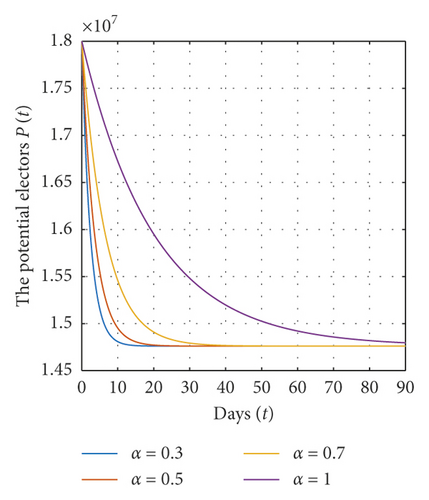
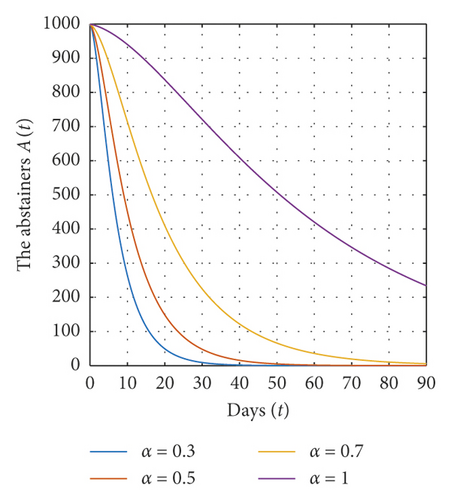
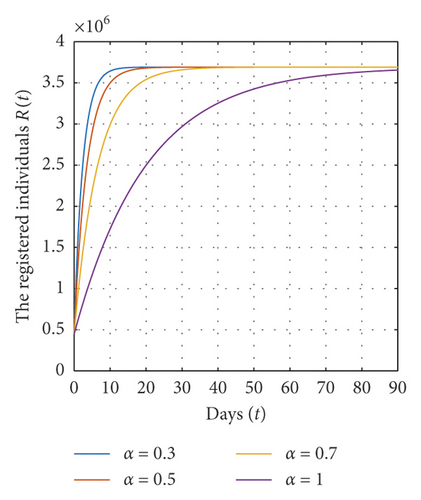
For a fixed value of α and for different initial values for each variable of state, we show in Figure 2 that the solutions converge to the abstaining-free equilibrium E0 = (14.76 × 106, 0,3.7 × 106) when ℜ0 = 0.8≺1, which implies that the abstaining-free equilibrium E0 of system (1) is globally asymptotically stable on Ω.
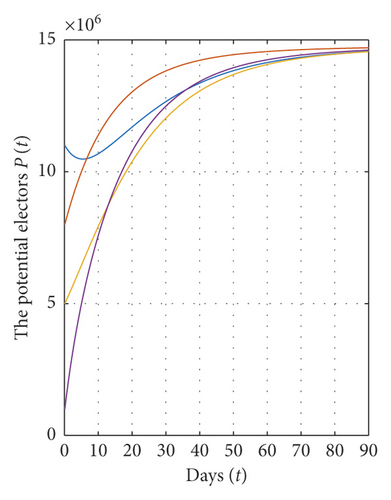
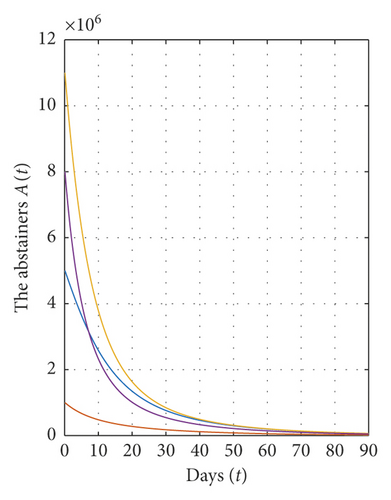
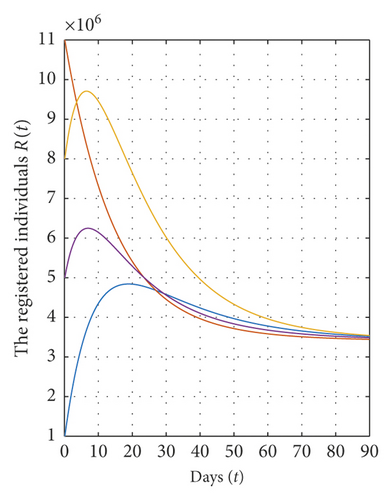
Concerning the stability analysis of the abstaining equilibrium E∗, we have E∗ = (2.85 × 106, 6.1433 × 106, 10.007 × 106) and ℜ0 = 1.79≻1 for Λ = 10.45 × 105, α = 0.15, β = 0.5, γ = 0.02, μ = 0.055, and tf = 90. In this case, according to theorem (9), the abstaining equilibrium E∗ of system (1) is globally asymptotically stable on Ω (see Figure 3).
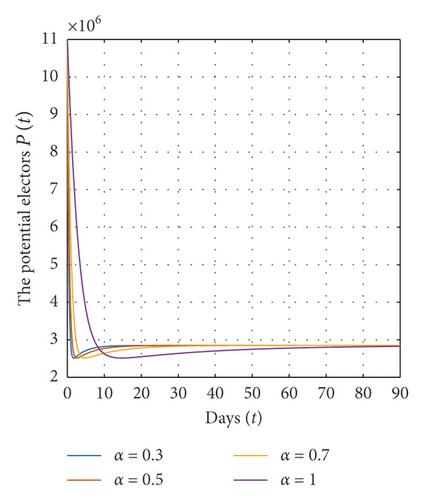
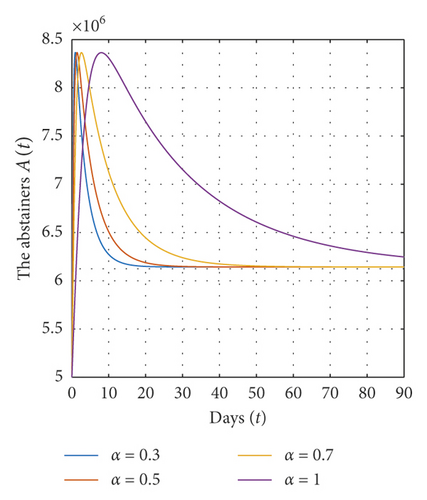
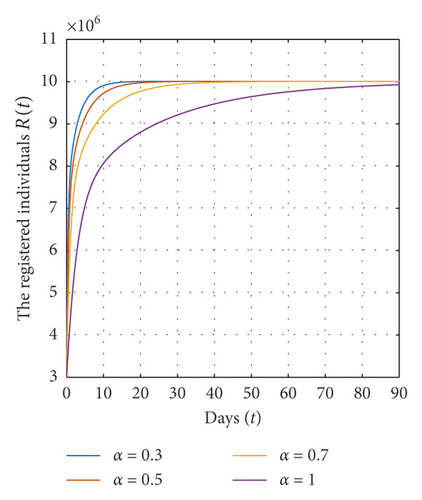
In addition, we show in Figure 4 that for a fixed value of α and for different initial values for each variable of state, the solutions converge to the abstaining equilibrium E∗ = (2.85 × 106, 6.1433 × 106, 10.007 × 106) and ℜ0 = 1.79≻1, which implies that the abstaining equilibrium E∗ of system (1) is globally asymptotically stable on Ω.
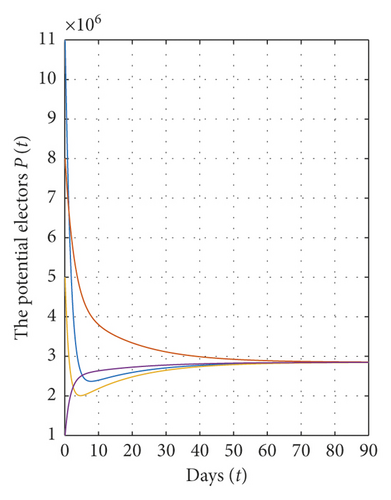

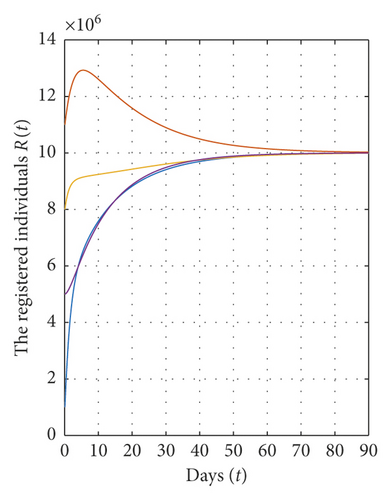
From all these figures, we show that the equilibrium points E0 and E∗ of system (1) are globally asymptotically stable on Ω if the conditions of theorems (7) and (9) are satisfied. Also, all solutions of model (1) converge to the equilibrium points E0 and E∗ for different values of α. In addition, the solutions converge rapidly to their steady state when the value of α is very small.
6. Conclusion
In this work, we presented a fractional-order model that describes the dynamics of citizens who have the right to register on the electoral lists and the negative influence of abstainers on the potential electors. By using the Routh–Hurwitz criteria and constructing Lyapunov functions, the local and the global stability of abstaining-free equilibrium and abstaining equilibrium are obtained. The numerical simulation was carried out using Matlab.
Conflicts of Interest
The authors declare that there are no conflicts of interest regarding the publication of this paper.
Open Research
Data Availability
The disciplinary data used to support the findings of this study have been deposited in the Network Repository (http://networkrepository.com/proÖle.php).




